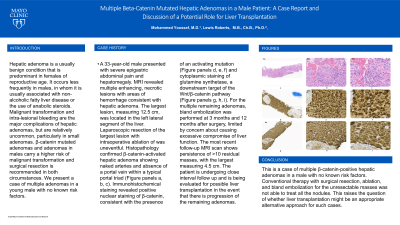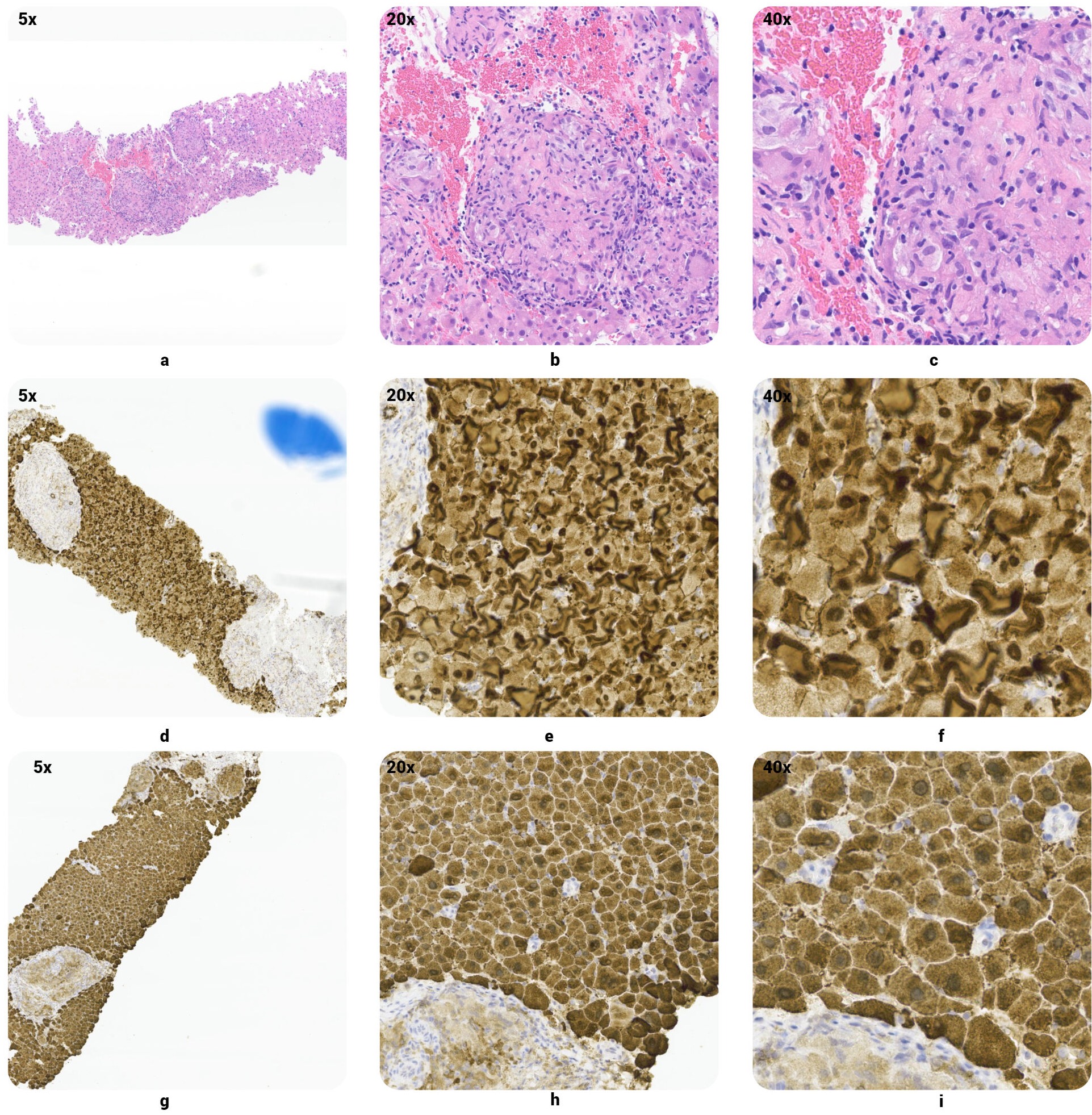Sunday Poster Session
Category: Liver
P1139 - Multiple Beta-Catenin Mutated Hepatic Adenomas in a Male Patient: A Case Report and Discussion of a Potential Role for Liver Transplantation
Sunday, October 22, 2023
3:30 PM - 7:00 PM PT
Location: Exhibit Hall

Has Audio

Mohammed Youssef, MD
Mayo Clinic
Rochester, MN
Presenting Author(s)
Mohammed Youssef, MD, Roberts Lewis, MB, ChB, PhD
Mayo Clinic, Rochester, MN
Introduction: Hepatic adenoma is a usually benign condition that is predominant in females of reproductive age. It occurs less frequently in males, in whom it is usually associated with non-alcoholic fatty liver disease or use of anabolic steroids. Malignant transformation and intra-lesional bleeding are the major complications of hepatic adenomas, but are relatively uncommon, particularly in small adenomas. b-catenin mutated adenomas and adenomas in males carry a higher risk of malignant transformation and surgical resection is recommended in both circumstances. We present a case of multiple adenomas in a young male with no known risk factors.
Case Description/Methods: A 33-year-old male presented with severe epigastric abdominal pain and hepatomegaly. MRI revealed multiple enhancing, necrotic lesions with areas of hemorrhage consistent with hepatic adenoma. The largest lesion, measuring 12.5 cm, was located in the left lateral segment of the liver. Laparoscopic resection of the largest lesion with intraoperative ablation of was uneventful. Histopathology confirmed b-catenin-activated hepatic adenoma showing naked arteries and absence of a portal vein within a typical portal triad (Figure panels a, b, c). Immunohistochemical staining revealed positive nuclear staining of b-catenin, consistent with the presence of an activating mutation (Figure panels d, e, f) and cytoplasmic staining of glutamine synthetase, a downstream target of the Wnt/b-catenin pathway (Figure panels g, h, i). For the multiple remaining adenomas, bland embolization was performed at 3 months and 12 months after surgery, limited by concern about causing excessive compromise of liver function. The most recent follow-up MRI scan shows persistence of >10 residual masses, with the largest measuring 4.5 cm. The patient is undergoing close interval follow up and is being evaluated for possible liver transplantation in the event that there is progression of the remaining adenomas.
Discussion: This is a case of multiple b-catenin positive hepatic adenomas in a male with no known risk factors. Conventional therapy with surgical resection, ablation and bland embolization for the unresectable masses was not able to treat all the nodules. This raises the question whether liver transplantation might be an appropriate alternative approach for such cases

Disclosures:
Mohammed Youssef, MD, Roberts Lewis, MB, ChB, PhD. P1139 - Multiple Beta-Catenin Mutated Hepatic Adenomas in a Male Patient: A Case Report and Discussion of a Potential Role for Liver Transplantation, ACG 2023 Annual Scientific Meeting Abstracts. Vancouver, BC, Canada: American College of Gastroenterology.
Mayo Clinic, Rochester, MN
Introduction: Hepatic adenoma is a usually benign condition that is predominant in females of reproductive age. It occurs less frequently in males, in whom it is usually associated with non-alcoholic fatty liver disease or use of anabolic steroids. Malignant transformation and intra-lesional bleeding are the major complications of hepatic adenomas, but are relatively uncommon, particularly in small adenomas. b-catenin mutated adenomas and adenomas in males carry a higher risk of malignant transformation and surgical resection is recommended in both circumstances. We present a case of multiple adenomas in a young male with no known risk factors.
Case Description/Methods: A 33-year-old male presented with severe epigastric abdominal pain and hepatomegaly. MRI revealed multiple enhancing, necrotic lesions with areas of hemorrhage consistent with hepatic adenoma. The largest lesion, measuring 12.5 cm, was located in the left lateral segment of the liver. Laparoscopic resection of the largest lesion with intraoperative ablation of was uneventful. Histopathology confirmed b-catenin-activated hepatic adenoma showing naked arteries and absence of a portal vein within a typical portal triad (Figure panels a, b, c). Immunohistochemical staining revealed positive nuclear staining of b-catenin, consistent with the presence of an activating mutation (Figure panels d, e, f) and cytoplasmic staining of glutamine synthetase, a downstream target of the Wnt/b-catenin pathway (Figure panels g, h, i). For the multiple remaining adenomas, bland embolization was performed at 3 months and 12 months after surgery, limited by concern about causing excessive compromise of liver function. The most recent follow-up MRI scan shows persistence of >10 residual masses, with the largest measuring 4.5 cm. The patient is undergoing close interval follow up and is being evaluated for possible liver transplantation in the event that there is progression of the remaining adenomas.
Discussion: This is a case of multiple b-catenin positive hepatic adenomas in a male with no known risk factors. Conventional therapy with surgical resection, ablation and bland embolization for the unresectable masses was not able to treat all the nodules. This raises the question whether liver transplantation might be an appropriate alternative approach for such cases

Figure: Histological slides
Disclosures:
Mohammed Youssef indicated no relevant financial relationships.
Roberts Lewis indicated no relevant financial relationships.
Mohammed Youssef, MD, Roberts Lewis, MB, ChB, PhD. P1139 - Multiple Beta-Catenin Mutated Hepatic Adenomas in a Male Patient: A Case Report and Discussion of a Potential Role for Liver Transplantation, ACG 2023 Annual Scientific Meeting Abstracts. Vancouver, BC, Canada: American College of Gastroenterology.
